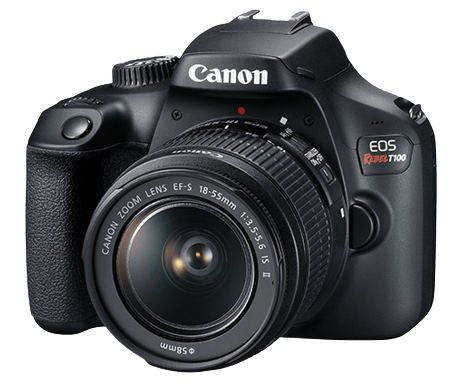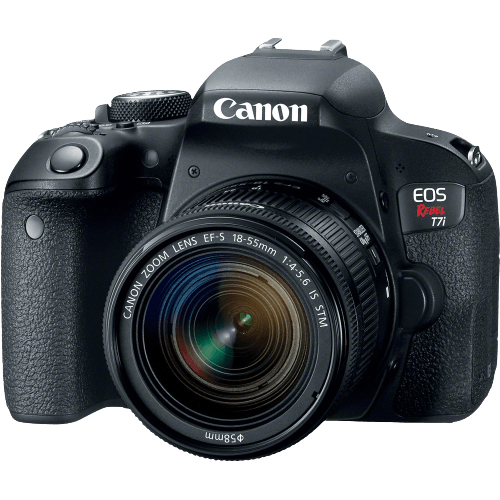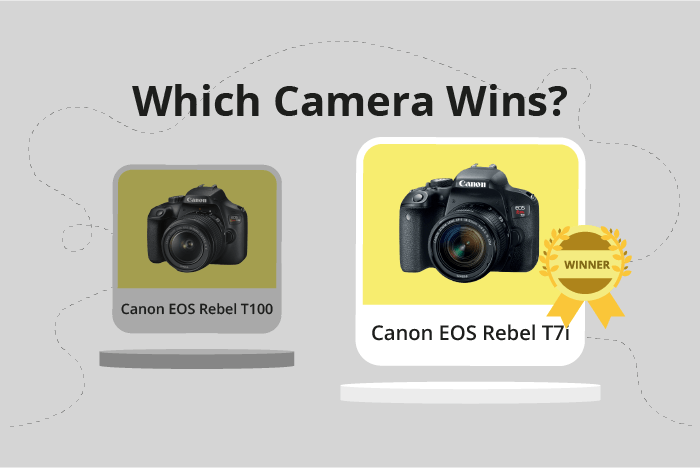Canon EOS Rebel T100 / 4000D vs EOS Rebel T7i / 800D Comparison
Canon EOS Rebel T100 / 4000D

Canon EOS Rebel T7i / 800D

The Canon EOS Rebel T7i/800D outperforms the Canon EOS Rebel T100/4000D with a score of 64/100, a 23-point difference. Both cameras are DSLRs and were released in 2017 and 2018, respectively. They share similar dimensions, with the T7i/800D being slightly larger and heavier.
The T7i/800D is superior in terms of performance and features, justifying its higher launch price of $779 compared to the T100/4000D’s $400. On the other hand, the T100/4000D offers a more affordable option for those on a budget, without compromising too much on quality.
Considering the specifications and scores, the T7i/800D is a better camera for those seeking advanced features and performance, while the T100/4000D is a suitable choice for budget-conscious buyers.
Canon EOS Rebel T100 / 4000D vs EOS Rebel T7i / 800D Overview and Optics
The Canon EOS Rebel T7i / 800D emerges as the winner in the optics comparison with a score of 64/100, while the Canon EOS Rebel T100 / 4000D scores 39/100. Both cameras share some common specifications, including the CMOS sensor type, APS-C sensor size, Canon EF-S lens mount, and lack of image stabilization.
The T7i / 800D outperforms the T100 / 4000D in several aspects. Firstly, it has a higher megapixel count at 24 compared to the T100’s 18, resulting in better image resolution. Secondly, the T7i has a faster shooting speed of 6, which is double the T100’s 3, allowing for better capturing of fast-moving subjects. Additionally, the T7i boasts a more advanced Digic 7 processor, providing faster image processing and improved noise reduction. Lastly, the T7i has a higher DXOMARK score for the sensor at 79, compared to the T100’s 63, which indicates better overall image quality.
On the other hand, the T100 / 4000D does not have any specific advantages over the T7i / 800D in terms of optics. Both cameras share the same shortcomings, such as the lack of image stabilization.
Considering the above points, the Canon EOS Rebel T7i / 800D clearly offers superior optics performance compared to the Canon EOS Rebel T100 / 4000D. With its higher megapixel count, faster shooting speed, advanced processor, and better DXOMARK score, the T7i is the more capable camera in terms of optics. The T100, while sharing some common specifications, falls short in comparison and does not offer any specific advantages over the T7i.
Canon EOS Rebel T100 / 4000D vs EOS Rebel T7i / 800D Video Performance
The Canon EOS Rebel T7i / 800D outperforms the Canon EOS Rebel T100 / 4000D in video capabilities, with a higher video score of 70 compared to 43. Both cameras share some common specifications, such as Full HD maximum video resolution and 1920 x 1080 maximum video dimensions.
The T7i / 800D excels in its maximum video frame rate, offering 60fps compared to the T100 / 4000D’s 30fps. This higher frame rate allows for smoother video playback and better slow-motion effects. Additionally, the T7i / 800D has built-in time-lapse functionality, which the T100 / 4000D lacks. This feature enables users to create stunning time-lapse videos without the need for external tools or software.
While the T100 / 4000D falls behind in these aspects, it still delivers Full HD video quality, which may be sufficient for casual users or beginners who do not require advanced video features. However, its lower video score reflects its limited capabilities compared to the T7i / 800D.
Considering these points, the Canon EOS Rebel T7i / 800D is the superior camera for video capabilities due to its higher frame rate and built-in time-lapse functionality. The Canon EOS Rebel T100 / 4000D, while offering Full HD video quality, is more suited for those who do not prioritize advanced video features.
Canon EOS Rebel T100 / 4000D vs EOS Rebel T7i / 800D Features and Benefits
The Canon EOS Rebel T7i / 800D emerges as the winner in this comparison with a feature score of 70/100, while the Canon EOS Rebel T100 / 4000D trails behind with a score of 47/100. Both cameras share some common specifications, including Wi-Fi and Bluetooth connectivity.
The T7i / 800D outshines the T100 / 4000D in several aspects. The winning camera boasts a larger screen size of 3 inches compared to the T100 / 4000D’s 2.7 inches. Furthermore, the T7i / 800D has a significantly higher screen resolution of 1,040,000 dots, whereas the T100 / 4000D has a resolution of only 230,000 dots. The T7i / 800D also features a touchscreen, a flip screen, and GPS, all of which are absent in the T100 / 4000D.
On the other hand, the T100 / 4000D does not hold any particular advantage over the T7i / 800D. The only aspect where both cameras are on par is their connectivity options, as both have Wi-Fi and Bluetooth. Nevertheless, the T100 / 4000D’s lower score reflects its inferiority in terms of features.
To sum up, the Canon EOS Rebel T7i / 800D is a superior camera due to its larger screen, higher screen resolution, touchscreen, flip screen, and GPS functionalities. Meanwhile, the Canon EOS Rebel T100 / 4000D lags in these areas, and its only similarity to the T7i / 800D is the shared Wi-Fi and Bluetooth connectivity. Therefore, the T7i / 800D is a better choice for photographers seeking advanced features and improved user experience.
Canon EOS Rebel T100 / 4000D vs EOS Rebel T7i / 800D Storage and Battery
The Canon EOS Rebel T7i / 800D wins the storage and battery comparison with a score of 29/100, while the Canon EOS Rebel T100 / 4000D scores 27/100. Both cameras have one memory card slot and accept SD, SDHC, and SDXC cards.
The T7i/800D outperforms the T100/4000D in battery life, providing 600 shots compared to the T100/4000D’s 500 shots. The T7i/800D also uses the LP-E17 battery type, whereas the T100/4000D uses the LP-E10. Neither camera offers USB charging.
Although the T100/4000D has a lower score, it shares the same memory card compatibility as the T7i/800D, with the exception of UHS-I compatibility. Both cameras lack USB charging capabilities.
Comparing the two cameras, the T7i/800D excels in battery life, while the T100/4000D matches the T7i/800D in memory card compatibility, except for UHS-I compatibility.
Canon EOS Rebel T100 / 4000D vs EOS Rebel T7i / 800D – Our Verdict
Are you still undecided about which camera is right for you? Have a look at these popular comparisons that feature the Canon EOS Rebel T100 / 4000D or the Canon EOS Rebel T7i / 800D:

